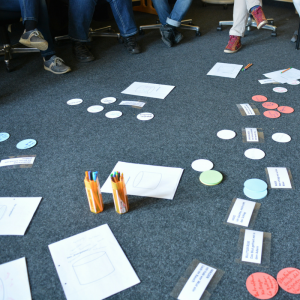Brainstorming settlement ideas is a crucial component of the collaborative process.
Collaborative practice provides an open environment that encourages everyone on the team to participate. The participants should feel as though their thoughts are being heard and their interests validated. Collaborative professionals will encourage active listening in a casual environment.

The brainstorming step follows the clients’ identification of goals and interests. Brainstorming is a fast-paced exercise in which the participants have no time to self-evaluate or to form preconceptions about any options suggested. Ideas should be tossed out to the group in an uninhibited, creative fashion.
Someone on the collaborative team will pull out the chalkboard or the flipchart and the multicolored pens. One team member will record every idea, taking brief notes so that ideas are not forgotten or misplaced, and team members are able to build on ideas that have already been mentioned and noted on the board.
No suggestion is a “bad” one. The team should be encouraged to think “outside the box” and discouraged from criticizing or complimenting any of the ideas, especially at this time.
Avoid evaluation at this point to sustain receptivity to all the potential alternatives. Offering a wide variety of options, which later can be compared and contrasted to each other, which in turn sometimes leads to options yet unidentified, ultimately leads to the best chance of reaching a settlement that addresses the clients’ most important concerns and interests.

Before brainstorming, the professionals should remind participants of their goals, encourage them to forget about their positions, and coach them to focus on their interests. They will urge the divorcing couple to explore options, even if they do not feel that they are feasible alternatives.
In brainstorming, small components are easier to manage than large issues, so implement a course of baby steps. Begin brainstorming by discussing what choices are already working for the spouses.
Next, develop objective standards for a plausible agreement. Talk openly and frankly, bouncing ideas off of one another.
Discuss reasonable hypothetical scenarios. Here the professionals will suggest alternative approaches that have worked in other cases, bringing their expertise to the table.
The team should limit itself to a specific period of time or number of ideas for this session. This will maintain the quick pace of brainstorming which is important when generating options.
Once the participants have offered many ideas, begin to tweak and trade possibilities in order to move toward the final settlement. Evaluation begins here; this is the time to explore solutions further, using conventional approaches. Determine how the participants’ interests can be met by the proposed solutions. Discuss the cost and benefit to each client for each item. Take time to have each step into the other’s shoes and analyze whether s/he would be happy with the proposal if s/he was on the opposing side.
Through effective brainstorming, collaborative team participants are able to explore many different scenarios in their pursuit to reach an effective settlement agreement.













